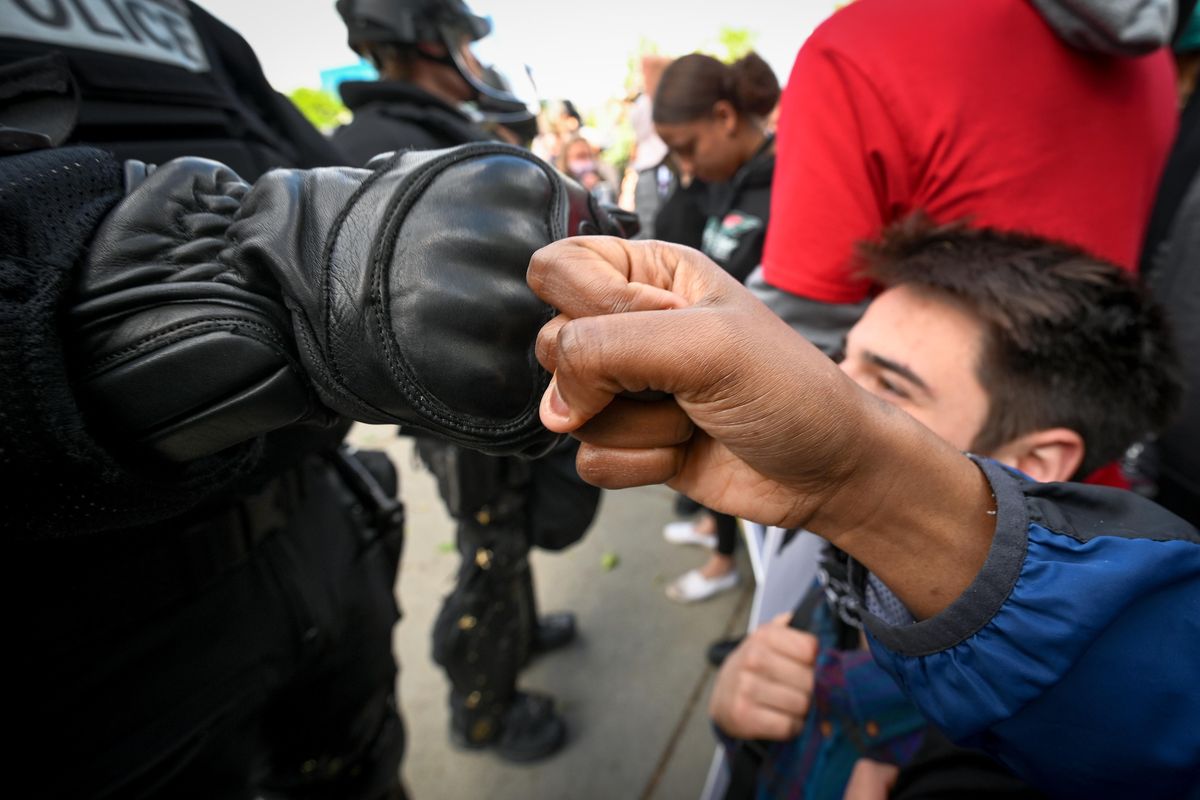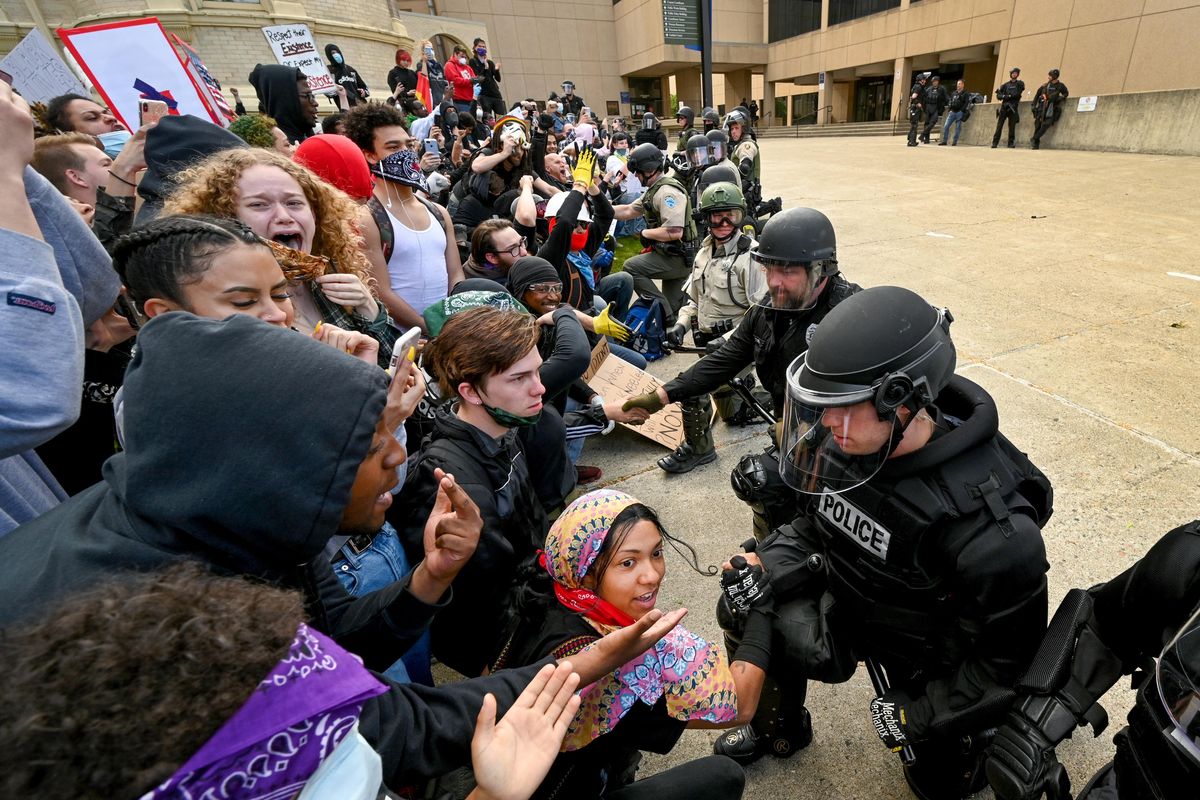Thousands march in Spokane on Sunday to protest George Floyd’s death, police brutality

Thousands of protesters marched through downtown Spokane on Sunday in a show of anger, strength and unity following the death of George Floyd, a Black man who died in police custody in Minneapolis last week.
The protest was set to start at 2 p.m., but a crowd of several dozen people carrying signs already had gathered near the Red Wagon in Riverfront Park by 1 p.m., Spokane police Chief Craig Meidl among them.
The crowd grew to more than a thousand within an hour. Many left the park and crossed Spokane Falls Boulevard, blocking traffic, to a parking lot where police in riot gear held them back amid some scuffles. The gathering then turned into a march and eventually included several thousand people. Chants of “No justice, no peace, no racist police,” and, “Hey hey, ho ho, these racist cops have got to go,” rang out on the streets.
Protesters streamed across the Monroe Street Bridge and through Riverfront Park toward the Spokane County Courthouse and Public Safety Building, where they were met with many more police in riot gear.
“I don’t know how to even count this many people. And to see this many young people picking up the torch to force change, I can’t even describe how I feel right now,” 76-year-old Marry Ann Torres said, through tears.
Torres has been politically active for most of her life, including the past 20 years in Spokane. The last time she said saw a protest of a similar size, she said, was when the United States went to war with Iraq.
“I’ve been participating in this kind of politics all my life, but this really beats them all,” Torres said. “I have never seen anything like this in Spokane – ever.
“There’s a lot of us old folks who can’t do this anymore, so seeing this many people doing it – I don’t know if it makes me feel hopeful, but it thrills the hell out of me.”
Protests have broken out across the country following Floyd’s death on Monday in Minneapolis. Derek Chauvin, the white officer who is seen placing his knee on Floyd’s neck in a video of the deadly encounter, has been arrested and charged with murder and manslaughter. Three other officers were fired.
Curfews have been instituted in Portland, Seattle – where protests in recent days have sometimes turned violent – and now Spokane.
But before the events in Spokane turned violent Sunday evening – with police firing large amounts of tear gas and pelting demonstrators with foam, rubber and bean-bag projectiles – there were moments of catharsis among the crowd at the courthouse: At least half a dozen police officers and sheriff’s deputies gave in to protesters’ demands to “take a knee” – a form of silent protest popularized by NFL player Colin Kaepernick.
Officers John Tyler and Keith Gonsalves were the first to do so, prompting many in the crowd to cheer wildly. A few moments later, Gonsalves heard a protester say she was thirsty and handed her a bottle of water.
Tensions rose when a few protesters began throwing rocks at officers. The rocks quickly stopped flying, but not before officers readied canisters of tear gas, sending murmurs through the crowd.
Some protesters cursed and mocked the officers in riot gear, while others approached them to have one-on-one conversations. A few used the opportunity to spray-paint graffiti on parts of the courthouse campus, including a sentry booth outside a parking lot typically reserved for police vehicles.
“Respect goes both ways,” said a protester named Monique who fist bumps a Spokane Police officer dressed in riot gear outside the Spokane County Courthouse. Thousands marched in Spokane on Sunday to protest George Floyd’s death, police brutality. (Colin Mulvany / The Spokesman-Review)Buy a print of this photo
Naiombi Jones held a sign that read “Black Lives Matter – Say their names.” It also featured photos of more than 100 Black people killed by police in the United States. A native of California, Jones drove from Omak in north-central Washington to attend Sunday’s protest.
Living in a rural town and working as a substance abuse counselor, Jones said she deals with prejudice on a daily basis.
“Being a biracial woman, I face challenges every day,” Jones said. “It’s predominantly white and you know it’s a country town. I can’t really expect anything more or less.”
Jones said she wasn’t nervous about protesting despite the protest in Seattle turning violent the day before. She said she felt a guarding presence from the faces she held on the sign above her head.
“Hopefully their spirits are with me while I’m here,” Jones said.
Carol Gray brought her six children, all wearing face masks, to the demonstrations at the behest of her 14-year-old daughter.
“Actually she was my advocate. She wanted to come out and do this,” Gray said of her daughter, Cinaiah. “We come from a multiracial family, and we experience racism on a daily basis.”
While Gray was glad to see so many people show up for the protest, she was also bothered that it seemed necessary.
“It warms my heart, but … we shouldn’t have to gather on somebody’s death in Minneapolis, Minnesota,” Gray said.
Cinaiah Gray said she fears for her family’s safety every day.
“Anything could happen, any day, if we don’t fight for justice,” she said.
Cars honked and motorcycles revved as they passed the crowd in Riverfront Park. At least one downtown business, the Apple Store on Main Avenue, had boarded up its windows ahead of the protests, and pedestrian access was limited near the Public Safety Building on the county courthouse campus.
Markalene Blackcrow held a sign at the corner of Summit Parkway and Monroe Street with the names of three missing and murdered Native Americans.
“I’m out here because I’m afraid for our country, and I’m afraid for our people,” Blackcrow said.
As the protesters began to disperse in the late afternoon, Shelby Ingram manned a table near the courthouse piled high with bottled water, snacks and containers of milk – which protesters use to neutralize tear gas on their faces.
“I just came by myself and am doing what’s needed,” Ingram said.
Many demonstrators stressed the importance of simply showing up.
“The grassroots has to stay involved, stay pressing the issue, stay in their face about it,” said one protester, 31-year-old Travis Brown. “Call your local Congress representatives, leave them a message, show up if you can. Leave your mayors messages. Show up. Write them. Fax them. Facebook. … Do whatever you got to do.”
Kurtis Robinson, president of the Spokane chapter of the NAACP, took part in the courthouse rally and communicated with some officers and deputies at the front line. As for the sheer size of the crowds, he said, “Spokane means it.”
Robinson said he appreciated that the demonstrations until then had been mostly nonviolent. But he said, “I know that the time is coming where we won’t be able to keep these peaceful. They cannot keep gunning down our Black and Brown people.”
Lambertine Muntu, 24, also attended the courthouse rally. She’s Black and originally from Germany, where she said she experienced pervasive, but less overt, forms of racism than she’s experienced in the United States. She’s lived in Spokane for about seven years.
“My mom wanted to come” to the protests, Muntu said. “I told her not to come because who knows what could happen?”
She said she was dismayed by those who resort to violence, and yet she understands why some do.
“We want peace. It’s all we want,” she said. “Peace and justice and love.”



































